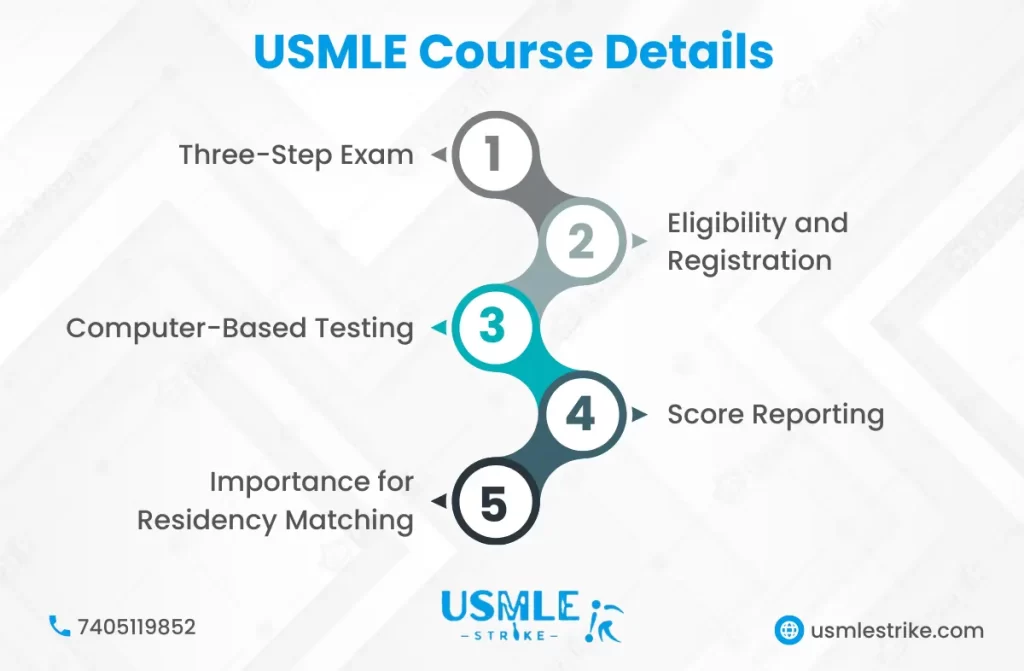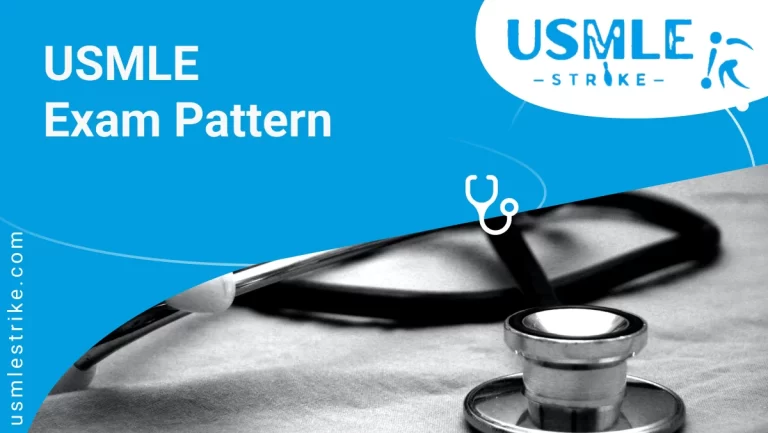The United States Medical Licensing Examination (USMLE) is a three-step exam designed to assess the knowledge and skills of medical students and graduates. The USMLE is required for all medical students and graduates seeking medical licensure in the United States. The USMLE exam pattern is designed to evaluate the ability to apply medical knowledge, concepts, and principles to patient care.
This article will explore the USMLE exam pattern for the year 2024, delving into the essential components of each step.
USMLE Exam Pattern 2024
The USMLE exam pattern 2024 varies between steps as each step has a distinct objective in evaluating a specific set of skills and abilities. For instance, Step 1 gauges the candidate’s grasp of basic scientific concepts and their ability to apply them in medical practice, while Step 2 CK assesses the candidate’s ability to gather patient information and perform physical exams.
It is crucial for applicants to familiarize themselves with the specific exam pattern of the step they are taking in 2024. This will provide them with a comprehensive understanding of the purpose of each step, the disciplines covered, the format of the exam, and its length.

Step 1:
To be eligible, you must be a medical student or a graduate of an accredited medical school in the United States or Canada. You must also meet identification and legal requirements and follow the scheduling and testing policies of the USMLE program.
- It is a one-day examination that assesses a medical student’s understanding of basic science concepts and principles.
- It covers topics such as anatomy, physiology, biochemistry, pharmacology, and microbiology.
- The score is reported on a scale of 1 to 300, with higher scores indicating a better performance.
Format and Duration
The USMLE Step 1 exam pattern consists of 280 multiple-choice questions, with a maximum score of 300. The total testing time is 8 hours, which is divided into seven 60-minute blocks of test items.

Step 2 Clinical Knowledge (CK):
To be eligible for CK, you must meet the same requirements as for Step 1.
- It is a one-day examination that assesses a medical student’s ability to apply medical knowledge in a clinical setting.
- It covers topics such as internal medicine, surgery, pediatrics, obstetrics/gynecology, and psychiatry.
- The score is reported on a scale of 1 to 300, with higher scores indicating a better performance.
Format and Duration
The USMLE exam pattern for CK exam consists of 318 multiple-choice questions, divided into eight 60-minute blocks. The total testing time is 9 hours.
Step 3:
To be eligible for USMLE Step 3, you must have completed all the requirements for the MD degree, including completion of USMLE Step 1, Step 2 CK. Additionally, you must have at least one year of postgraduate medical training or be a graduate of a residency program that is accredited by the (ACGME) or the Royal College of Physicians and Surgeons of Canada. You must also meet identification and legal requirements and follow the scheduling and testing policies of the USMLE program.
- It is a two-day examination that assesses a physician’s ability to diagnose and treat patients in a real-world setting.
- It covers topics such as internal medicine, surgery, pediatrics, obstetrics/gynecology, and psychiatry.
- The score for this USMLE exam pattern is reported on a scale of 1 to 300, with higher scores indicating a better performance.
Format and Duration
The USMLE exam pattern for day 1 consists of multiple-choice questions, with a total testing time of 7 hours divided into six 60-minute blocks and day 2 consists of computer-based case simulations, with a total testing time of 9 hours divided into six 45-minute blocks.
USMLE Exam Details
| USMLE Test Step | Exam Type | Total Duration | Number of Questions | Skills Assessed |
|---|---|---|---|---|
| Step 1 | Computer-based | 1 Day | 7 blocks of 40 MCQs, 280 in total | Basic Science Concepts + Application to medical practice |
| Step 2 | Computer-based | 1 Day | 316 MCQs across 8 blocks | Computer-based |
| Step 3 | Basic Science Concepts + Application to Medical Practice | 2 Days | 233+180 MCQs across 6 blocks (Day 1 & 2) +13 computer-based simulations | Application to Medical Practice + Basic Science Concepts |
USMLE Exam Syllabus
The USMLE exam pattern is divided into three steps, each focusing on different areas of medical education.
- USMLE Step 1 Syllabus:
- Focuses on basic sciences such as:
- Anatomy
- Biochemistry
- Microbiology
- Pathology
- Pharmacology
- Physiology
- Behavioral Sciences
- Key concepts include disease mechanisms and therapeutic principles.
- Focuses on basic sciences such as:
- USMLE Step 2 CK (Clinical Knowledge) Syllabus:
- Covers clinical sciences, including:
- Internal Medicine
- Surgery
- Pediatrics
- Obstetrics and Gynecology
- Psychiatry
- Focuses on applying medical knowledge to clinical scenarios.
- Covers clinical sciences, including:
- USMLE Step 3 Syllabus:
- Emphasizes clinical management and decision-making.
- Divided into two parts:
- Foundations of Independent Practice (FIP): Epidemiology, ethics, and patient safety.
- Advanced Clinical Medicine (ACM): Clinical diagnosis, therapeutic interventions, and case simulations.
Mastering the detailed USMLE exam pattern and syllabus for each step is key to success. Focus on high-yield topics and practice frequently to ensure a solid grasp of the required disciplines.
USMLE Pattern – Scoring
The USMLE exam pattern is designed to assess a candidate’s ability across different knowledge areas and is scored on a three-digit scale.
- USMLE Step 1 Scoring:
- Step 1 is graded on a pass/fail basis (as of 2022).
- Candidates need a score of 194 or above to pass.
- While it is pass/fail, the performance on Step 1 remains a crucial factor in residency applications, especially in competitive specialties.
- USMLE Step 2 CK Scoring:
- Step 2 CK requires a passing score of 214 or higher.
- This step evaluates the clinical knowledge required for patient care.
- USMLE Step 3 Scoring:
- Step 3 requires a minimum score of 198.
- This step tests your readiness for unsupervised medical practice, including real-world decision-making.
Total Marks of USMLE Step 1
The total marks for USMLE Step 1 are structured around a series of 280 multiple-choice questions (MCQs). These are divided into 7 blocks, with 1 hour allocated per block. Although the exam is now pass/fail, a thorough understanding of the exam’s structure remains crucial for achieving a high score, which can still indirectly influence residency applications.
The key to mastering this step is understanding the USMLE exam pattern and regularly practicing mock exams, focusing on time management and understanding complex medical concepts.
USMLE Exam Details – Eligibility Criteria
To be eligible for the USMLE exam, candidates must meet certain criteria:
- Medical Students: You must be enrolled in, or have graduated from, a medical school that is listed in the World Directory of Medical Schools (WDMS).
- Graduates: For Step 3, candidates must have successfully completed Step 1 and Step 2 CK.
- Exams Must Be Taken in Order: Candidates must pass each step before moving on to the next.
Being aware of these eligibility criteria is essential to ensure that you’re ready for each step of the USMLE exam pattern.
Conclusion
Thus, to become licensed to practice medicine in the United States, medical graduates must pass all three steps of the USMLE. It is important to start preparing from the USMLE Step 1 exam pattern besides checking with the specific state medical board for more information.
Read also: FMGE Exam Pattern





